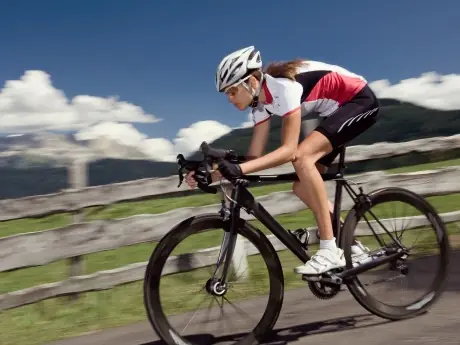
No matter the goal you want to tackle this summer, you’re going to need a plan. We got Sweeney and Rusch’s longtime coach Dean Gorlich to walk us through the concepts he used to develop their near-superhuman strength in a flash—concepts which can benefit cyclists of all levels. Here are the trio’s best tips for going from zero to hero.
Assess Your Weaknesses
There’s no doubt that Rebecca Rusch—four-time winner of the Leadville Trail 100 and seven-time world champion—is fit; Gorlich knew she wouldn’t just need to work on her aerobic base or top-end speed. Instead, he zeroed in on the one thing that was likely to get her: the altitude. Kilimanjaro tops out at more than 19,000 feet above sea level. While Rusch lives and trains in Idaho, which has good opportunities for low-level elevation work, it’s doesn’t offer anything close to the thin air she’d be experiencing.
“We tried to train as high as we could,” says Gorlich. Rusch spent several days working on altitude training at the Olympic Training Center, where a special room simulates what exercising any given altitude will feel like. Over the span of a few days, Gorlich helped Rusch transition from training at 10,000 feet to working at 17,000 feet.
More: High-Altitude Training Destinations
Don’t have access to the Olympic Training Center? Neither do we. But Gorlich says that mere mortals can get much of the same benefits from renting an altitude tent and sleeping in it for a few weeks.
If you can’t do that, Sweeney says his go-to workout for simulating that “can’t breathe” feeling is two-minute-long efforts at 85 percent of max exertion while breathing only through your nose. He’d cycle through two minutes on with two minutes of recovery for 40 minutes.
Set an Appropriate Pace
When Gorlich cranked the altitude room up to the “no air” setting, Rusch felt it in a bad way. Gorlich says you could see it on her face. “So we said, okay, what’s our pace at this altitude? Athletes will do okay if they know how to pace themselves properly,” he says.
To dial in your pace, you need to find the toughest portion of the event you’ll be tackling and simulate it in training. The goal is not to get yourself fitter but to figure out just how slow you need to go to make it through and still have energy to finish. Watch your power, heart rate, and speed, and take note of where you can pedal onwards and where you crash and burn.
Identify and Practice Essential Skills—And Emergency Ones
Fitness is only one part of getting to the finish line. Sweeney and Rusch had to navigate dirt trails with plenty of rock gardens and obstacles along the way. To keep face-planting to a minimum, Sweeney practicedtechnical climbing skills. “When I rode up to Everest Base Camp, I did a lot of extra [bike-]carrying because my skills weren’t refined enough. So I practiced riding up stairs, balancing over boulders, stuff like that.”
Even if your insane goal has you sticking to the pavement, there are plenty of secondary but truly valuable skills to work on. Can you grab a bottle from a feed zone? It’s harder than it looks and many don’t try it for the first time until race day. Can you hop a curb to avoid a crash?
Build Base and Top-End Fitness
You can’t do any sort of distance event without logging some longish miles. (Actually, maybe you could, but it would definitely be a miserable experience come Event Day.) Because she’s an elite athlete, Rusch had tons of base fitness in her system. But if she hadn’t, Golich says that would definitely have been on her training docket. Sweeney was in a similar position, but he still did a few all-day slogs. “Make sure you put in one or two ultra-long days,” Sweeney says. “Before I rode the Iditarod Trail Invitational, I went down to Cape Cod and rode just about the entire length of the Cape and back on the sand. I had the entire beach to myself and that one training session built a ton of confidence.”
Going anaerobic and being able to recover are important, too. Even if you have no intention of sprinting at your goal event, high-intensity training builds fitness fast. Plus, you never know when you’re going to need a little extra get-up-and-go. Sweeney did 10-minute blocks of 15 seconds at an all-out sprint followed by 15 seconds of recovery. Repeat until your eyes go blurry.
Hone Your Mind
Sweeney says positive self-talk is so effective that it’s basically free training. But, like all things, you shouldn’t wait until the big day to try it.
“Every workout I did was part of my mental preparation. I was focused on putting myself somewhere on the climb and trying to imagine how I’d feel,” he says. Then he’d practice talking himself through it.
Also, Sweeney likes to think of every single workout as “money in the bank.” On the day of your big goal event, think back on all the hours you’ve put in: Recalling the work you’ve done will help you feel prepared to face whatever stands between you and the finish line.
More: 6 Mental Tricks to Reach Your Goals
Get Strong
If your adventure will require any pushing, hucking, or hike-a-biking, you need to develop core, shoulder, and leg strength.
Sweeney carried a 50-pound pack for much of his trek, so to prepare, he did multi-hour hikes in the mountains with 30-pound weights in his pack. He also hit the gym several days a week for box jumps, squats, and single-leg squats. Every night, he spent 15 minutes doing core work to make sure he’d have the strength he needed to keep his back strong as the mountain got steeper and steeper.









Discuss This Article